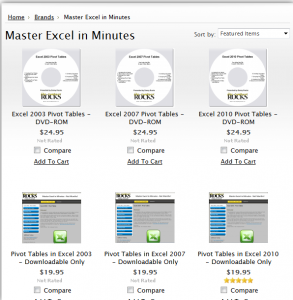New! Now available from the online store at www.thecompanyrocks.com
Do you ever have one of those “A-ha” moments? You know – those moments when everything falls into place. When everything becomes crystal clear. When you finally “get it!”
Well, here is your opportunity to experience 50 “A-ha” moments. Here is a great way for you to learn “The 50 Best TIps, Tricks, and Techniques for Microsoft Excel 2007.”
I spent almost three months filming these short Excel training videos. I worked hard to create this DVD in order to make it easy for you to learn how to remain productive at work while learning to use the new Excel 2007 interface.
And, the Excel 2007 interface is really quite different.
So different, that many long-time Excel users just give up on it and return to the tried and true Excel 2003 program.
And that is too bad. Because, Excel 2007 allows you to perform so many business tasks faster and better. But … first, you must get over “the initial learning curve” to understand how to navigate in Excel 2007.
This DVD makes it easy for you to learn how to use Microsoft Excel 2007 – guaranteed!
In selecting the 50 Best Tips for Excel 2007, I wanted to include tricks that all Excel users could put to use – now! I include tips at the Introductory, Intermediate and Advanced levels.
Each lesson is short – five to six minutes on average – and focused on just one topic. Each lesson on the DVD is self-contained – I teach you how to solve one problem per lesson.Overall, the DVD contains 5 1/2 hours of training on Excel 2007!
This DVD is available exclusively from the SkillPath Seminars bookstore. They are offering it for sale at the introductory price of $49.95 Here is a link to the demonstration / order now page.
I am proud of this product. I know that you will gain some new insights into how to get the most out of Excel 2007. I welcome your feedback. Please drop me a note – danny@thecompanyrocks.com Or … add your comments below for all readers to share.
Thank you for your support!
Danny Rocks




